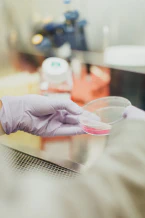Unlocking Sight: The Revolutionary Prosthetic Device for the Visually Impaired

Using Electrical Activity to Allow Individuals to See: An Introduction to Prosthetic Devices
Prosthetic devices have come a long way in recent years, and one of the most exciting advancements is the development of devices that use electrical activity to allow individuals to see. In a recent presentation, a scientist discussed the potential for prosthetic devices to improve the lives of those with retinal degenerative diseases and blindness.
The retina is a critical part of the eye that converts visual information into electrical activity. When someone looks at an image, it goes into their eye and lands on the front-end cells, called photoreceptors. The middle part of the retina then extracts information from the image and converts it into a code in the form of patterns of electrical pulses that are sent to the brain. These patterns of pulses literally mean something, like “baby’s face,” and allow the brain to understand what the person is seeing.
However, when someone has a retinal degenerative disease, the front-end cells die, and over time, all the cells and the circuits that are connected to them also die. Until the only thing left are the output cells that send signals to the brain, but because of all that degeneration, they aren’t sending any signals anymore. As a result, the person’s brain no longer gets any visual information, and they become blind.
The solution to this problem is to build a prosthetic device that can mimic the actions of the front-end circuitry and send signals to the retina’s output cells. This device consists of an encoder and a transducer. The encoder mimics the action of the front-end circuitry and converts images into the retina’s code, while the transducer makes the output cells send the code up to the brain. The result is a retinal prosthetic that can produce normal retinal output, even in a completely blind retina.
This is a significant advancement in prosthetic devices as it allows individuals to see things they couldn’t before. With the standard method, patients can see high-contrasted edges and light, but nothing close to normal vision has been possible. However, with the encoder-transducer device, firing patterns from the blind animal treated with it closely match the normal firing patterns. This development has the potential to improve the lives of those with retinal degenerative diseases and blindness.
The Development of a Prosthetic Device for Treating Blindness
The development of a prosthetic device for treating blindness has been a significant challenge for scientists for many years. There are ten million people in the U.S. and many more worldwide who are blind or facing blindness due to diseases of the retina, such as macular degeneration. Unfortunately, there is little that can be done for them, and for the vast majority of patients, their best hope for regaining sight is through prosthetic devices.
However, current prosthetics don’t work very well and are still limited in the vision that they can provide. Patients can see simple things like bright lights and high contrasted edges, but nothing close to normal vision has been possible. The key problem is that these devices don’t provide the right code to the brain.
The solution to this problem is a device that can produce the right code, allowing the brain to understand what the person is seeing. This is where the encoder-transducer device comes in. The encoder mimics the action of the front-end circuitry and converts images into the retina’s code, while the transducer makes the output cells send the code up to the brain. This allows the person to see things they couldn’t before.
The potential impact of this technology on a patient’s ability to see is significant. In a reconstruction experiment, scientists were able to reconstruct what the retina was seeing from responses from firing patterns. The results were impressive, and the encoder-transducer device was able to produce much better output than the standard method.
This development has the potential to change the lives of many people facing blindness due to retinal degenerative diseases. The encoder-transducer device can produce normal retinal output, even in a completely blind retina, and allow individuals to see things they never thought possible. It’s exciting to see the progress that has been made in prosthetic devices and the potential for even more advancements in the future.
The Limitations of Current Prosthetics for the Visually Impaired
The current prosthetics for the visually impaired are limited in their capabilities. These devices are only able to provide limited vision, such as the ability to see high contrasted edges and bright lights, but not much more than that. They don’t provide a comprehensive view of the world, and it can be challenging for individuals to complete everyday tasks with them.
One issue with current prosthetics is that they don’t provide the right code to the brain. The brain relies on a specific pattern of electrical pulses to understand what the person is seeing. When the prosthetic device doesn’t provide the right code, it’s challenging for the brain to understand what the person is seeing. This limits the amount of information that the prosthetic device can provide.
Another limitation of current prosthetics is their inability to adapt to changes in the environment. The world around us is constantly changing, and the prosthetic device must be able to keep up with these changes. Unfortunately, current devices are not dynamic enough to adapt to changes in the environment. This makes it challenging for individuals to navigate their environment and complete everyday tasks.
The limitations of current prosthetics make it challenging for individuals with visual impairments to live their lives to the fullest. However, advancements in technology, such as the encoder-transducer device, have the potential to change this. By providing the right code to the brain, individuals may be able to see things they never thought possible. It’s an exciting time for prosthetic devices, and the potential for even more advancements in the future is promising.
The Retina and the Process of Converting Information into Electrical Activity
The retina is a part of the eye that takes in images and sends them to the brain as patterns of electrical activity. When an image is focused on the retina, it lands on the front-end cells, called photoreceptors. The middle part of the retina, the retinal circuitry, extracts information from the image and converts it into a code, which is a pattern of electrical pulses that gets sent up to the brain. These patterns of pulses represent specific objects or scenes, and the brain understands them as such.
In a healthy retina, the pattern of pulses produced is dynamic and changes all the time, reflecting the constantly changing world that we see. However, when someone has a retinal degenerative disease like macular degeneration, the front-end cells die, and the cells and circuits connected to them die over time too. As a result, the person’s brain no longer receives any visual information, and they become blind.
To address this problem, prosthetic devices can be developed to mimic the actions of the front-end circuitry and send signals to the output cells of the retina. The goal is to restore normal vision by providing the brain with the same patterns of electrical activity that a healthy retina produces. This is what the speaker in the video has been working on, using a device that consists of an encoder and a transducer to convert images into the retina’s code and then send them up to the brain as electrical signals.
The problem of retinal degenerative diseases and blindness
Retinal degenerative diseases like macular degeneration can cause blindness by damaging the front-end cells of the retina, the photoreceptors. Over time, all the cells and circuits connected to them die too, until only the output cells are left. These cells no longer send signals to the brain due to degeneration, so the person loses their vision. There are currently no effective treatments for these diseases, leaving prosthetic devices as the best option for regaining sight. However, current prosthetics are limited and can only provide limited vision such as seeing simple things like bright lights and high-contrasted edges. They cannot provide anything close to normal vision. This is why there is a need to develop better prosthetics that can restore normal vision to those with retinal degenerative diseases.
Introducing the Encoder and Transducer Components of the Prosthetic Device
The encoder and transducer components of the prosthetic device work together to mimic the actions of the front-end circuitry of the retina, which extracts information from incoming images and converts it into a code made up of patterns of electrical pulses. The encoder component replaces the retinal circuitry with a set of equations that can be implemented on a chip. When an image is fed into the encoder, it produces streams of electrical pulses that resemble those produced by a normal retina.
The transducer component takes the output signals from the encoder and sends them to the retina’s output cells, allowing them to send normal signals to the brain. This means that even a completely blind retina, with no front-end circuitry or photoreceptors, can produce normal retinal output, enabling the brain to understand what the person is seeing.
Compared to standard prosthetics that use light detectors but no encoder, the encoder-transducer device is able to produce firing patterns that closely match those of a normal retina. In addition, the encoder-transducer device was able to reconstruct an image of a baby’s face from the firing patterns recorded from a blind animal treated with the device. This demonstrates the potential power of being able to communicate with the brain in its language and understand the code.
Improving firing patterns in the blind with the encoder-transducer device
The encoder-transducer device is designed to improve firing patterns in the blind, allowing them to process visual information in a more natural way. The device has been tested on animals with promising results.
The device works by converting visual information into electrical signals that can be transmitted to the brain. The encoder component of the device receives visual input and converts it into a series of electrical pulses that represent the visual scene. The transducer component of the device then delivers these electrical pulses to the retina, stimulating the remaining healthy cells and creating a pattern of electrical activity that the brain can interpret as visual information.
Studies have shown that this device can improve firing patterns in the retina of blind animals, allowing them to perceive visual information more accurately. This technology could one day be used to treat human patients with retinal degenerative diseases, such as retinitis pigmentosa and age-related macular degeneration.
In addition to improving firing patterns in the retina, the encoder-transducer device has also shown promise in improving visual acuity. In animal studies, blind animals were able to navigate mazes and recognize visual patterns with the help of the device.
The potential applications of the encoder-transducer device are numerous and exciting. If further testing proves successful, this technology could change the lives of millions of people suffering from blindness or visual impairment, allowing them to see the world in a whole new way.
Understanding the Brain’s Language: The Potential for Further Applications in Treating Deafness and Motor Disorders
The technology used in the development of the encoder-transducer prosthetic device for treating blindness has opened up potential applications in other areas of medicine. Researchers are investigating the possibility of using similar techniques to help individuals with deafness and motor disorders.
In the case of deafness, the same principle of converting information into electrical activity can be applied. By stimulating the auditory nerve, electrical signals can be sent to the brain, allowing individuals with deafness to perceive sound. This technology is still in the early stages of development, but it holds great promise for those who are deaf or hard of hearing.
Similarly, the encoder-transducer technology can be applied to motor disorders, such as Parkinson’s disease. By stimulating specific areas of the brain, electrical signals can be sent to help control tremors and other symptoms associated with the disease. While this research is still in the experimental stage, it could lead to significant improvements in the quality of life for those suffering from motor disorders.
Overall, the potential applications of the encoder-transducer technology are exciting, and they have the potential to transform the way we treat a range of medical conditions. By understanding the language of the brain and using electrical signals to communicate with it, we can open up new possibilities for restoring sensory function and improving motor control in individuals with a range of medical conditions.
Conclusion
Prosthetic devices have come a long way in recent years, particularly in the field of assisting individuals with vision loss. The development of the encoder-transducer device is a significant breakthrough, offering the potential for restoring sight to those with certain types of retinal degenerative diseases.
Although there are still limitations to the device, it is clear that it has a promising future, especially as researchers continue to work on improving the firing patterns in the brain. The encoding process is an essential step in the development of more advanced prosthetic devices that can provide greater visual acuity and more natural visual experiences.
Moreover, the potential for similar technology to be used in treating other conditions, such as hearing loss and motor disorders, is an exciting prospect. Understanding the brain’s language is a crucial factor in this field, and continued research could lead to significant breakthroughs.
Overall, the development of the encoder-transducer device is a remarkable achievement, offering new hope to individuals with retinal degenerative diseases. With continued advancements and research, it is possible that even more advanced prosthetic devices could become available in the future, bringing about an era of unprecedented assistance and support for individuals with disabilities.







